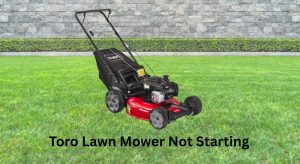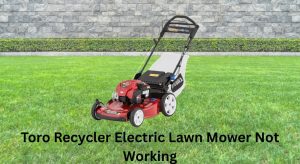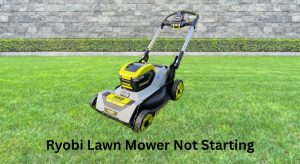Nothing derails a weekend faster than a lawn mower not starting. Whether it’s a push mower, self-propelled, or a riding mower, the most common issues usually have simple fixes: check fresh fuel, a clean air filter, and a good spark plug first. Many mowers will fire up after replacing old gas and cleaning or replacing the spark plug.
In this guide, you’ll get step-by-step methods to diagnose and fix your lawn mower not starting—from quick checks to advanced troubleshooting. We’ll cover gas, electric, and riding mowers, and help you prevent the problem from coming back. By the end, you’ll know exactly what to do to get your mower running today.
Common Causes of a Lawn Mower Not Starting
- Old or stale fuel (over 30-60 days old)
- Clogged carburetor or fuel jet
- Dirty or unplugged spark plug
- Flooded engine
- Clogged air filter
- Safety switch not engaged (bail bar, seat switch, brake/clutch)
- Dead or weak battery (riding or electric mower)
- Blown fuse or faulty ignition switch (riding mowers)
- Blocked fuel filter or fuel line
- Choke not set correctly or faulty choke cable
- Water in fuel tank
- Low oil level or oil sensor lockout (some models)
- Faulty starter motor or solenoid (riding mowers)
- Sheared flywheel key (after hitting a rock)
- Bad coil/ignition module (no spark)
How to Fix a Lawn Mower Not Starting

Method 1: Quick Start Checks (5–10 minutes)
These are the fastest fixes that solve most no-start problems.
Diagnosing the Issue
- Does the engine crank but not fire? Fuel, air, or spark issue.
- No crank at all? Likely battery, safety switch, fuse, or starter issue (for electric/riding mowers).
- One “pop” or fires then dies? Fuel delivery or choke issue.
Fix Steps
- Use fresh fuel
– Drain old gas if it’s older than 60 days. Refill with fresh, ethanol-free fuel if possible (or use a fuel stabilizer). - Set the choke
– Cold start: full choke; Warm start: half or no choke. - Check the spark plug
– Pull the plug boot, remove the plug, clean with a wire brush or replace. Gap typically 0.028–0.031 in (0.7–0.8 mm)—check your manual. - Inspect the air filter
– Paper filter: tap to clean; replace if dark and clogged.
– Foam filter: wash with soap and water, dry, oil lightly, reinstall. - Verify safety controls
– Push mower: hold bail bar tightly; Riding mower: sit on seat, set brake, blades off, neutral gear.
Testing
- Try starting again per the proper choke/primer steps. If it starts and dies, proceed to the carburetor section.
Method 2: Fix Fuel Delivery Problems (15–45 minutes)
If you have spark but the engine won’t run, fuel delivery is the next suspect.
Diagnosing the Issue
- Primer bulb doesn’t firm up or fuel line appears empty.
- Engine fires with starter fluid but won’t stay running.
- Fuel leaks or strong varnish smell.
Fix Steps
- Replace or clean fuel filter
– Inline filters are cheap; install with flow arrow pointing toward carburetor. - Inspect fuel line and tank
– Look for cracks/kinks. Replace hardened lines; clean tank if debris present. - Clean the carburetor bowl and jet
– Turn off fuel valve (or clamp hose).
– Remove bowl nut (often the main jet). Clean holes with carb cleaner and a thin wire. Clean bowl and float needle area.
– Reassemble with a new bowl gasket if torn. - Add fuel system cleaner
– Add a small dose of carb/fuel treatment to fresh gas to dissolve varnish.
Testing
- Prime per instructions and start. If it runs only on choke, the main jet is still partially clogged—repeat cleaning or proceed to full carburetor cleaning.
Method 3: Restore Ignition/Spark (10–30 minutes)
No spark equals no start.
Diagnosing the Issue
- Plug remains dry after many pulls—likely fuel issue.
- Plug wet and still no start—likely spark issue or flooding.
- Test for spark: ground plug threads to engine, pull rope—look for blue spark.
Fix Steps
- Replace the spark plug
– Use manufacturer-recommended plug (e.g., NGK BPR5ES, RJ19LM—varies by engine). - Check spark plug wire and boot
– Ensure snug fit; look for cracks. - Inspect the coil/ignition module gap
– Set gap to about 0.010–0.014 in (use a business card as a spacer) between coil and flywheel magnets. - Disconnect the kill wire temporarily
– If mower starts with kill wire disconnected, a safety switch or the switch circuit is shorting.
– Important: Be prepared to stall engine by removing fuel or choking; reconnect wire immediately after test.
Testing
- Start the mower. If spark is intermittent, replace the coil/ignition module.
Method 4: Full Carburetor Clean or Rebuild (30–90 minutes)
Stale fuel can varnish the carburetor, especially after winter storage.
Diagnosing the Issue
- Engine only runs on choke.
- Starts and dies after a few seconds.
- Surging idle or no fuel in bowl.
Fix Steps
- Remove carburetor
– Photograph linkage and springs.
– Disconnect fuel line (clamp it), throttle/choke linkages, and mounting bolts. - Disassemble
– Remove float bowl, float pin, float, needle, main jet, emulsion tube, idle jet. - Clean thoroughly
– Soak metal parts in carb cleaner; blow out all passages with compressed air. Do not damage soft jets with oversized wires. - Replace wear parts
– Install new gaskets, needle/seat, O-rings from a carb kit for your carb model (e.g., Briggs & Stratton, Honda GCV, Kohler). - Reassemble and reinstall
– Ensure correct linkage orientation and secure all gaskets.
Testing
- Start the mower with fresh fuel; adjust idle mixture/speed per manual if adjustable.
Method 5: Fix Flooding or Choke Issues (5–15 minutes)
Diagnosing the Issue
- Strong fuel smell, wet spark plug, engine won’t start.
- Choke plate stuck closed.
Fix Steps
- Clear flooding
– Remove plug, pull starter 6–10 times to vent cylinder, let sit 10 minutes, install dry/new plug.
– Start with choke off and throttle open. - Inspect choke operation
– Move lever—confirm plate opens/closes freely.
– Lubricate or adjust choke cable; replace if frayed.
Testing
- If it starts and runs only with choke off, problem solved. If it still floods, check float needle seating in the carb.
Method 6: Battery/Electrical for Riding and Electric Mowers (10–40 minutes)
Diagnosing the Issue
- No click/no crank: dead battery, fuse, key switch, brake/seat switch, or solenoid.
- Click but no crank: weak battery or bad starter/solenoid.
- Cranks but won’t start: fuel/spark issue (use earlier methods).
Fix Steps
- Test the battery
– 12.6V+ at rest is healthy; under 12.2V is low. Charge fully; replace if it won’t hold charge. - Check fuses and safety switches
– Inspect blade/PTO switch, seat switch, brake or clutch switch; replace faulty ones. - Inspect and clean grounds
– Remove/clean battery ground to frame and engine ground. Tighten terminals. - Test solenoid and starter
– Jump the solenoid posts carefully to test the starter. If starter spins, solenoid or control circuit is bad. If not, starter motor is suspect. - Key switch continuity
– Use a multimeter to verify positions (B to S, etc.) make contact.
Testing
- Attempt to start with brake set, PTO off, in neutral, seated. If still no crank, pursue professional diagnostics.
Method 7: Mechanical Issues (20–60 minutes)
Diagnosing the Issue
- Sudden stop after hitting a rock; now rope jerks back violently: likely sheared flywheel key (timing off).
- Rope hard to pull: hydrolock from oil/fuel in cylinder or blade obstruction.
- Low compression: worn rings/valves.
Fix Steps
- Check blade and deck
– Disconnect spark plug; tip mower carb side up. Clear obstructions. Ensure blade is tight and not bent. - Flywheel key replacement
– Remove flywheel nut and fan; use a puller to lift flywheel; replace the soft key; torque nut per spec. - Clear hydrolock
– Remove plug, pull cord to expel fluid; correct oil level; avoid overfilling oil. - Valve adjustment (OHV engines)
– Set valve lash to spec (e.g., 0.004–0.006 in intake/exhaust on many Briggs)—check manual.
Testing
- After repairs, start the engine. If compression remains low and starting is difficult, a cylinder leak-down test may be needed.
How to Prevent Future Starting Issues
- Use fresh fuel and add stabilizer if storing more than 30 days.
- Run the carburetor dry before off-season storage.
- Replace the spark plug annually.
- Clean or replace air filter every season.
- Change oil on schedule; keep oil level correct.
- Charge and maintain the battery (riding/electric mowers) over winter.
- Keep deck and cooling fins clean to prevent overheating.
Pro Tips
- Prime and choke correctly: Over-priming floods; under-priming won’t start.
- Use ethanol-free gas (E0) if available; ethanol attracts moisture and gums carbs.
- Install a fuel shutoff valve and run the carb dry after mowing.
- Keep a spare spark plug and inline fuel filter in your toolbox.
- Label fuel cans with purchase dates.
- If you hit a solid object, check the blade, crankshaft, and flywheel key before running again.
- Don’t tip a mower with the carburetor down—oil can flood the air filter and cylinder.
When to Call a Professional
- You smell fuel but can’t find the source (risk of fire).
- Starter clicks or smokes, or you see melted wiring.
- Repeated carb rebuilds don’t solve “runs only on choke.”
- Low compression, suspected bent crankshaft, or valve damage.
- For riding mowers: persistent no-crank after battery/solenoid checks.
What to look for in a service provider:
– Authorized dealer for your engine brand (Briggs & Stratton, Honda, Kohler, Kawasaki).
– Clear labor rates, warranty on parts/work (30–90 days typical).
– Seasonal turnaround times disclosed.
Typical costs:
– Basic tune-up: $80–$150 (push mower), $150–$350 (riding).
– Carburetor clean/rebuild: $60–$140 plus parts.
– Starter/solenoid: $60–$200 parts + labor.
– Coil/ignition module: $30–$90 parts + labor.
Warranty considerations:
– Using the wrong oil/fuel or neglecting maintenance can void warranty.
– Keep receipts for parts and fuel stabilizers during warranty period.
FAQ
Q: My lawn mower won’t start after winter. What should I do first?
A: Drain old gas, add fresh fuel with stabilizer, replace the spark plug, and clean or replace the air filter. If it still won’t start, clean the carburetor bowl and jet—stale fuel is the most common cause after storage.
Q: My mower starts then dies after a few seconds. Why?
A: This usually means the main jet is partially clogged or the fuel cap vent is blocked. Clean the carburetor jet and try starting with the fuel cap loosened to test venting.
Q: I smell gas and the plug is wet. Is the engine flooded?
A: Yes. Remove the spark plug, pull the cord several times to clear the cylinder, let it air out 10 minutes, install a dry plug, and start with no choke.
Q: How can I tell if my mower has no spark?
A: Remove the plug, reconnect the boot, ground the metal threads to the engine, and pull the rope. Look for a strong blue spark. No spark points to a bad plug, coil, kill switch circuit, or safety switch.
Q: My riding mower clicks but won’t crank. What’s wrong?
A: Likely a weak battery, corroded terminals, bad ground, or failing solenoid. Check battery voltage (12.6V healthy), clean connections, and test the solenoid.
Q: Does ethanol fuel cause problems?
A: It can. Ethanol absorbs moisture and can form varnish, clogging jets and degrading rubber fuel lines. Use fresh fuel, consider ethanol-free gas, or add stabilizer.
Q: Which way should I tip my push mower?
A: Always tip with the carburetor and air filter facing up (spark plug up) to avoid dumping oil into the intake.
Q: Is there a quick way to test if fuel delivery is the issue?
A: Yes. Spray a small amount of starting fluid into the intake. If the engine fires briefly, focus on fuel system cleaning (filter, lines, carburetor).
Alternative Solutions
Sometimes the fix isn’t worth the time if parts are worn or the mower is very old.
| Solution | Pros | Cons | Best For |
|---|---|---|---|
| Professional tune-up | Fast, thorough, warranty | Costly, seasonal delays | Busy schedules or complex issues |
| Replace carburetor with new | Quick, reliable | More expensive than cleaning | Heavily varnished carbs |
| Switch to battery-electric mower | Low maintenance, easy start | Battery cost/limited run-time | Small to medium lawns |
| Buy new gas mower | New warranty, efficiency | Upfront cost | Old, unreliable units |
Get Your Lawn Mower Working Again
Following this lawn mower not starting guide, you now have multiple solutions to diagnose and fix the problem:
– Refresh fuel, set choke correctly, and replace the spark plug
– Clean the air filter and carburetor bowl/jet
– Verify safety switches and electrical system
– Address flooding, battery, and mechanical issues
Don’t let a stubborn mower ruin your day. Start with the quick checks, then work methodically through fuel, spark, air, and safety circuits. With these steps, your lawn mower should be running smoothly again in no time.
Have you successfully fixed your lawn mower not starting? Share your experience and model details in the comments to help other readers. Found this helpful? Bookmark this guide for next season and avoid the same frustration.





